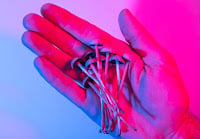Hallucinogen-Related ED Visits Associated With Schizophrenia Risk

Individuals who require emergency care after using hallucinogenic drugs have an increased risk of developing a schizophrenia spectrum disorder (SSD), according to a report issued yesterday in JAMA Psychiatry.
“Results from randomized clinical trials suggest that psychedelic-assisted psychotherapy may be beneficial for treatment-resistant depression, posttraumatic stress disorder, and alcohol use disorder,” wrote Daniel Myran, M.D., M.P.H., of the University of Ottawa, and colleagues. “However, there are ongoing concerns that hallucinogen use may increase the risk of serious adverse mental health outcomes, including psychosis, particularly when used outside supervised clinical settings and in populations at elevated risk of psychosis, who have historically been excluded from clinical trial.”
Myran and colleagues analyzed medical record data from 9.2 million individuals ages 14 to 65 enrolled in Ontario’s universal health insurance program between January 2008 and December 2021. The researchers identified 5,217 individuals who had an ED visit involving hallucinogen use, which encompassed both dissociative drugs like ketamine and psychedelics like LSD or psilocybin. Those who had an ED visit, hospitalization, or outpatient visit for psychosis in the five years prior to the hallucinogen-related ED visit were excluded.
The primary outcome was the development of an SSD, which was defined as a diagnosis of schizophrenia or schizoaffective disorder.
Individuals who had visited the ED due to hallucinogen use had a 21 times greater risk of developing an SSD within three years compared with the general population. After accounting for sociodemographic characteristics and comorbid mental and substance use disorders, those who had a hallucinogen-related ED visit still had a 3.5 times greater risk of developing an SSD. Additional findings included:
- The most common reasons for ED visits involving hallucinogen use were harmful use (36.6%), intoxication (22.2%) and poisoning from a substance other than LSD (16%).
- Individuals who visited the ED for hallucinogen-induced psychosis (3.5% of all visits) had the greatest risk of developing an SSD.
- Compared with the general population, those who visited the ED for hallucinogen use were younger and more likely to be male and live in low-income neighborhoods.
- The rate of individuals who visited the ED due to hallucinogen use was largely stable from 2008 to 2012, then increased by 86.4% between 2013 and 2021.
The authors noted that the data they studied did not include detailed information on the type of hallucinogens used. They also noted that the study did not establish a causal link between hallucinogen use requiring care in the ED and developing an SSD. “Nonetheless, our findings revealed a group that may have high risk of development of SSD who may benefit from close follow-up and intervention or preventative efforts,” they wrote.
For related information, see the Psychiatric News article “Marijuana, Hallucinogen Use Reach Historic Levels Among Young Adults.”
(Image: Getty Images/iStock/Yarphoto)
Don't miss out! To learn about newly posted articles in Psychiatric News, please sign up here.





